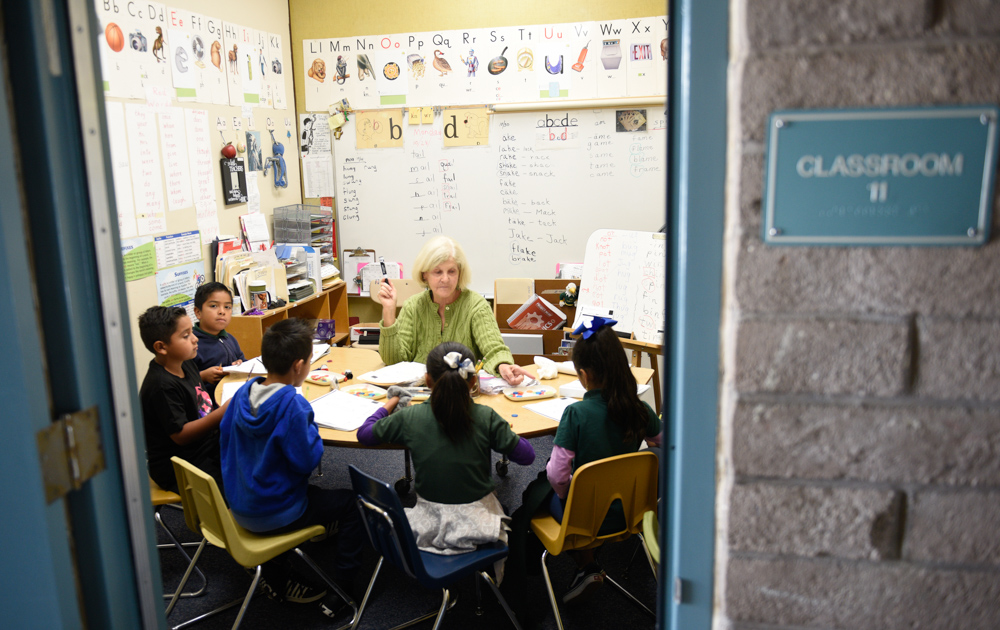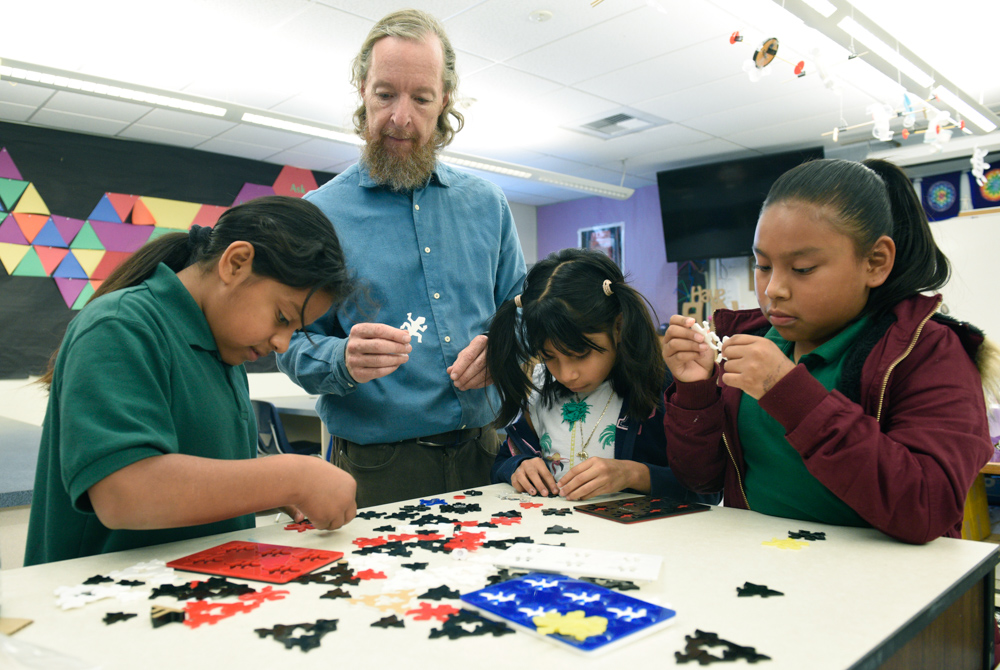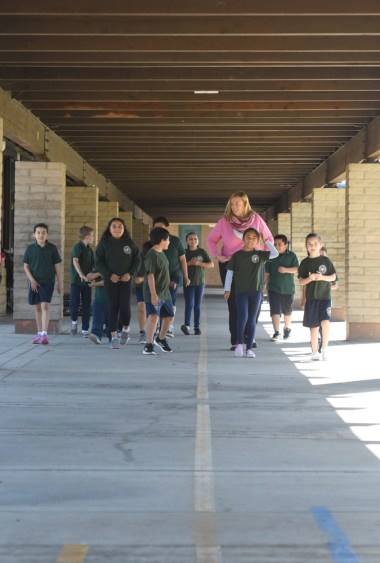Franklin Elementary’s Scores Are Off the Charts
How One of Santa Barbara’s Lowest-Performing Elementary Schools Got Really Good Grades
by Delaney Smith | Published November 7, 2019

For decades, Franklin Elementary has been one of Santa Barbara’s lowest-performing elementary schools. Worried parents living in the Eastside neighborhood would often seek intra-district transfers so their children could attend another school with higher test scores. In fact, just five years ago, Franklin was among the lowest-scoring elementary schools in the district.
A massive surprise came this year, though: When the standardized test scores were announced, Franklin students had the highest improvement of any school in the district. How did this happen?
Well, it didn’t happen overnight.
It Takes a Village
“We are one of the best-kept secrets in Santa Barbara,” said Casie Killgore, Franklin’s principal.
The turnaround came after Killgore began using her self-described “hustler skills” to bring new programs to the school.
Rather than relying on funding from the district, Killgore has taken an entrepreneurial approach to helping her students. In the decade that she has been principal, her “business model” has helped empower the staff and teachers to create a team that has brought sweeping academic changes. The entire team creates a family atmosphere for students and their families, many of them spending more time at Franklin than they do at home.
“This is a family effort from our office staff to staff to teachers to parents and kids to our neighbors,” Killgore said. “It takes a village to raise these kids, and we are blessed to have a good, dedicated one.”
Franklin is nestled in a densely populated, working-class neighborhood on Santa Barbara’s Eastside, where many families share residences to survive the city’s high rents. The school serves 680 students from pre-kindergarteners to 6th graders, more than 90 percent of whom come from low-income, Latino families.
Entering the campus from the outside feels like walking between two worlds. Inside the school’s walls, it’s hard to believe one isn’t inside a pricey private school. “This might be the only time these kids get to see manicured lawns and green spaces to play,” Killgore said. “Many of them live in apartments or don’t have front yards or backyards.”
Smaller Is Better
In California, increasingly larger class sizes have caused teachers to strike and parents to protest. Although teachers within the Santa Barbara district must conform to state mandates for class size, Franklin teachers have found a way to give students the advantages of smaller class sizes.
In all grades, children spend a large part of their day working in small groups of around six students, switching to different “stations” depending on the child’s understanding of the subject. Each group works on a different activity or task, and the teacher moves from group to group so that everyone gets one-on-one instruction by the end of the day.
The transition to small groups sometimes requires careful handling by the teacher. Parent Debbie Esparza, whose three daughters have attended Franklin, remembers how her oldest child resisted being in a group. But during a parent conference with her daughter’s 3rd-grade teacher, Leon Lewandowski, he explained that he wanted her to remain in the group to learn the social skills needed to get along in the real world. “I’m so grateful to Mr. Lewandowski,” she said. The whole group ended up thriving academically and as friends.
Teachers and staff, many of whom attended Franklin themselves, enroll their own children there. “I sent my own daughter here,” Killgore said. “Everyone who works here also sends their kids here, too. I didn’t even try to put her in a specific teacher’s class because I know they all provide the same quality of instruction.”
Killgore’s daughter was one of more than 30 other Franklin students whose parents also work at the school. Patty Aguilar, who has taught 1st grade at Franklin for 22 years, has daughters enrolled in 3rd and 5th grade. Her brother, Pedro Guillen, has been teaching 6th grade at the school for more than 25 years. “The focus and attention the kids get makes all of the difference,” Aguilar said.

The high level of technology displayed in each classroom adds to Franklin’s private-school aura. For example, in one 1st-grade class, a small group was doing a Lexia reading activity on their tablets while another group was sitting around a desk and working directly with the teacher and a third group was doing independent reading through a curved PVC pipe, similar to a phone, in order to hear themselves read aloud and break down each word.
The small-group model carries throughout the school. The kids who are recognized as needing extra help are sent to what is called Retired Teacher Intervention (RTI), a program funded by the district. While those kids go to RTI, which is taught by retired teachers from the district, Aguilar said the kids remaining in her class break up into even smaller groups to get more one-on-one attention from her.
The RTI groups are not unique to Franklin, but the way they are integrated into the school day is. The kids who are identified as struggling in reading or math are sent in groups of seven or fewer to another classroom. There, they work with the retired teachers for 45 minutes per day, four days a week, in seven-week cycles until they no longer need the extra assistance.
The program is similar to the district’s new dyslexia intervention program, which works with even smaller groups, with only two or three students per group.
The RTI team this year includes Gloria Hepp, Lois Moore, Maria Salas, and Chris Johnson. Called the Golden Girls by some of the young children, together the four have more than 150 years of teaching experience between them.
“The kids don’t even know it’s intervention because the teachers make it so fun,” Killgore said. “They’re usually running to go to intervention, they are so excited.”
Esparza’s two youngest daughters struggled with reading and were sent to intervention groups, and they now read above their grade level as a result. “These girls pick up thick chapter books now like it’s nothing,” she said.
Kitty Grae, the mom of a son in 2nd grade and a daughter in kindergarten at Franklin, said enrolling her kids at Franklin has been “one of the best decisions we ever made.” She feels that the teachers really fight for her son to learn and grow. “Moving to Franklin was a night-and-day difference,” Grae said. “It is a loving environment that welcomes needs and challenges. The small groups made all the difference in him being able to focus. He is just so much happier here. It is like a family.”

Preparation for the Next Phase
Although the small groups are successful, the school also recognizes that once the kids move on to junior high and high school, they won’t have the same environment. Beginning in older grades, students are introduced to sitting in rows as one large class, so they are prepared for 7th grade.
Franklin is one of five elementary schools that feed into Santa Barbara Junior High. Esparza said both her oldest daughters, Carolina and Susana, are getting straight As and are enrolled in honors classes at S.B. Junior High after leaving Franklin.
“We give these kids the emotional confidence in addition to academically preparing them,” Killgore said. “They leave Franklin and go to junior high knowing they belong in AP and honors classes, even though they might look different than the other kids in the class.”
She said Latino students, or other students of color, often “self-select” themselves out of an honors class because they feel they don’t belong there. It is hammered into Franklin’s culture early on that they belong in those classes when they graduate. Finding every student’s “pathway” is a huge part of helping them feel they belong after they graduate.
Extracurriculars are built into the students’ days, so by the time they reach 7th grade, they’ve found at least one pathway they excel at or enjoy and can continue it through junior high and high school. All students in upper grades play a musical instrument, for example.
Although all the district schools have a music requirement, Franklin has traditional or nontraditional instruments for students to choose from — drum sets, tubas, violins, or even accordions. Much of the funding comes from the district, but for some of the more unique instruments, Killgore used her “hustler” ways to get donations from the S.B. Bowl Education Outreach, S.B. Education Foundation, UCSB Arts & Lectures, Music Academy of the West, and the S.B. Accordion Association.
And although the art and music pathways are standard across the elementary schools in the district, other pathways are unique to Franklin. There is a pathway for STEAM, or science, technology, engineering, art, and mathematics. The STEAM lab includes a commercial-grade laser cutter that all grade levels can use to etch and cut wood for projects.
“This is the funnest job I’ve ever had after teaching for 30 years,” said Brendan Carroll, the STEAM teacher. He spent over a year at Dos Pueblos High School getting trained in how to use the laser cutter for his STEAM lab at Franklin.

Just like the other pathways and the intervention groups, students spend part of their school day in Carroll’s class in seven-week rotations. Four grades are in the STEAM rotation at a time, switching every seven weeks, for three rotations per year. When they aren’t in the STEAM class, they are in a different pathway for seven weeks — art, music, or garden.
“It is especially important for girls,” Carroll explained. “If girls aren’t specifically exposed to engineering by elementary school, they won’t touch it as an adult.”
He said his STEAM classes are aligned with what they learn in their main classroom. Currently, he has a 3rd-grade class studying global warming and water, so in his STEAM class, they are using the laser cutter to design houses that can withstand floods. His 4th-grade class just finished reading Island of the Blue Dolphins, so they are designing a wooden board game based on the book in his STEAM class.
The school also has a garden, which is another pathway unique to Franklin. The garden functions as a way for students to learn about growing food, the weather’s effect on plant growth, and even a little bit of cooking.
“You could have a kid who’s in college and has never seen a strawberry come out of the ground,” Killgore said, pointing to the strawberry plants in the garden. “A lot of these kids don’t have gardens in their backyards and won’t see this anywhere else.”
Much of the food is harvested and taken to the kitchen, she said. Some of the kids recently made chips out of the kale harvested from the garden, for example. In addition to some district money, the garden is funded by Explore Ecology, Audacious Foundation, the school district, and the Franklin PTA. Just like STEAM, the seven-week garden rotations are aligned with students’ lesson plans in their main classrooms.
When School Ends

“We have kids who are here from 7:30 a.m. to 7:30 p.m.,” Killgore said. “Some of these kids eat all three meals here.”
Killgore explained that there are three “tiers” to a day at Franklin. The first is the school day itself, which can vary depending on the student’s grade level, but ends by 3:10 p.m. at the latest. Once school is out, Franklin doesn’t shut down.
Tier two is the after-school program A-OK, which runs from the time school is out until 6 p.m. A-OK is funded through the district and is partnered with the city’s Parks and Recreation Department to offer sports, homework help, and other off-campus field trip activities that vary on the school year. The after-school program is also offered at Adams, Adelante Charter, Cleveland, McKinley, and Santa Barbara Community Academy elementary schools.
In addition to A-OK, Franklin has a free after-school sports camp run by James Coronado, a parent and teacher at the school, as well as a city-sponsored sports program. And two days a week, Franklin partners with the Music Academy of the West’s Choir program.
“Dance class, karate — we have it all here,” Killgore said. “We just bring everything right here so there is a central hub. Parents don’t have to get off work. If they don’t have a car, they don’t have to worry about driving their kids somewhere. It’s all here.”
The concept of meeting all students’ needs (academic or otherwise) in one location is amplified even more during the third tier of the day. After A-OK and other after-school activities end, the Franklin Service Center stays open until 8:30 p.m. Since it began five years ago, it has served as a community center on Franklin’s campus, serving not just students but also their parents and neighbors.
“When I first started here, all I heard was, ‘Oh, these poor parents,’” Killgore said. “I was like, ‘How do we break that stereotype? It isn’t true.’ We basically just brought everything parents or students need here, so there are no excuses for why a student can’t succeed. We have high expectations, but we also provide the resources to meet those expectations.”
Alejandra Gutierrez, the executive director of the Franklin Service Center, who is now running for a seat on the Santa Barbara City Council, shares Killgore’s hustler mentality and found a way to fund almost all of the needs that weren’t being met before.
The center employs Santa Barbara City College student tutors to help Franklin students with their homework Monday-Thursday from 5 to 7 p.m. While children are being tutored, an English as a Second Language course is being held in a nearby classroom for Spanish-speaking parents on Mondays and Wednesdays from 5 to 7 p.m. Gutierrez secured funding for this in a partnership with SBCC’s School of Extended Learning.

“The really cool part of it is the communication between the tutors and the teachers,” Gutierrez said. “If the kids are really struggling with something, we can let the teachers know. Some kids suffer from anxiety and are afraid their work isn’t good enough, and we can tell their teacher, ‘Hey, so-and-so worked really hard on this and is very nervous about doing a bad job,’ and the teacher can accommodate that.”
The center also partnered with the Foodbank of Santa Barbara County last year after the 1/9 Debris Flow. When it became apparent how great the Eastside’s need for food security was, Gutierrez was able to keep the partnership going. Twice a month, the Foodbank brings free groceries to the service center and feeds anywhere from 80 to 100 families. Once a month, the center holds a Kid’s Farmers’ Market, teaching the children how to make meals with the ingredients and then sending them home with produce. Most recently, they gave the kids fruit to make fruit salad.
The center also brings in a doctor from the County Department of Public Health every Wednesday from 5:30 to 8 p.m. to see any families without health insurance or who have Medi-Cal. For the families who don’t have insurance, the center also has a Medi-Cal representative from County Social Services to help parents or other Eastside community members sign up for Medi-Cal.
“Probably 80 percent of the students in my [1st-grade] class go to either the Franklin Service Center or A-OK,” 1st-grade teacher Aguilar said. “This school is their home. They spend more time with us than they do at home sometimes.”
Franklin has come a long way. The district’s assistant superintendent of elementary education, Raul Ramirez, announced just last week that Franklin made the coveted list of campuses eligible to qualify as one of the California Distinguished Schools. Winners are given the California Distinguished School Award for outstanding education programs and practices.
In his announcement, Ramirez praised Franklin’s teachers and staff. “This is an incredible honor and a testament to your hard work, dedication, and heart for the kids and families you serve.”




You must be logged in to post a comment.